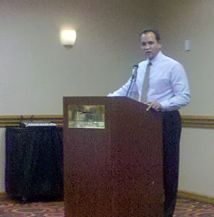I am somewhat reluctant to talk about politics in my blog because—as we all know—politics and education tend to make an explosive combination. Today, however, I am going to make an exception because I want to recognize, honor, and support a visionary politician who is not afraid to embrace a distinctly modern approach to education: US Congress Representative Rush Holt (D, 12thDistrict, NJ). We need more Renaissance men like Mr. Holt from all 50 states and both sides of the isle to stand up for high-quality world languages and international education for our kids.
So who is Congressman Rush Holt?
Rep. Holt has a Ph.D. in physics from NYU and in his distinguished career he has worked, among other places, as Assistant Director of the prestigious Princeton Plasma Physics Laboratory at Princeton University. It’s not everyday that we find a professional scientist in Congress, and he has put this scientific, research-oriented background to excellent work on the three committees in which he serves in the House: the Committee on Education and Labor, the Committee on Natural Resources, and the Permanent Select Committee on Intelligence.
As far as education is concerned, Mr. Holt has moved mountains not only for STEM disciplines (Science, Technology, Engineering, and Math), but also for neglected albeit critical areas such as early childhood education and world language and international education. As a member of the Intelligence Committee, he knows very well that America cannot continue to lead in the world without an educated citizenship well versed in languages and global affairs alongside technical knowledge. I don’t think I would be exaggerating one bit if I said that Mr. Holt is our #1 champion in Congress today (Senator Akaka, in Hawaii, also comes to mind).
I’ve had the privilege of listening to him on several occasions, and I follow his work closely as the leader of the JNCL-NCLIS “Legislative Day” delegation sent by Foreign Language Educators of New Jersey (FLENJ) to Congress each May. I can attest to the fact that Mr. Holt does in fact do as he says and does not just make empty promises.

In Congress: From left to right, Marty Abbott (ACTFL Director of Education), Ana Lomba (FLENJ), unidentified journalist, Rep. Rush Holt, Lisa Lilley (ACTFL 2010 Teacher of the Year), and Amanda Seewald (FLENJ).
We can still do more. We could establish grants for foreign language partnerships between local school districts and foreign language departments at institutions of higher education. We could create an Assistant Secretary for International and Foreign Language Education in the Department of Education, who would provide leadership in directing efforts aimed at international and foreign language education. –Rush Holt
But here is the important part—he didn’t just sit and wait. As of June 2010, he has conquered the second point (we now have a “Deputy Assistant Secretary” and not an “Assistant Secretary”—but hey! This is great progress in our field!). He is also working tirelessly on the first point through the House Bill H.R. 4065 Rep. Holt Foreign Language Education Partnership Program Act.

So what can you do to make sure that we continue to have great champions like Mr. Holt in Congress?
If you believe in the importance of receiving a well-rounded global education and you live in the New Jersey’s 12th district, then you may want to consider voting for Representative Rush Holt this November, when he is up for reelection.
And if you are outside the 12th district, you can help the cause by understanding where your politicians stand in this important area and asking them to support Mr. Holt’s H.R. 4065, its Senate version (once this is introduced in the Senate), and other pending or new legislation.
Ana Lomba
******
Ana Lomba is changing the way people think about and interact with young children learning languages. Her Parents’ Choice award-winning books, lively songs, games, stories, and mobile applications are quickly becoming favorites with teachers and parents who want to nurture young children’ inborn language abilities. Key to the success of Ana’s break-through method is a focus on the family as the ideal environment for early language learning – even her signature curriculum for language programs is built with parents in mind. Ana has taught toddler, preschool, elementary school, and college-level Spanish courses, and held leadership positions with some of the most influential language organizations in the US, including ACTFL, NNELL and FLENJ. After graduating with a law degree from Spain, her native country, Ana pursued graduate studies at Binghamton University, Princeton University, and NYU.